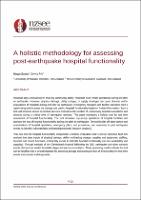A holisic methodology for assessing post-earthquake hospital functionality
Abstract
Hospitals play a critical role in ensuring community safety. Hospitals must remain operational during and after an earthquake. However, physical damage, utility outages, or supply shortages can cause closures and/or evacuations of hospitals during and after an earthquake. Emergency managers and facility operators need a rapid rating tool to assess the damage and predict hospital functionality based on limited information. Such a tool will improve access to medical services and reduce the number of unnecessary hospital evacuations and closures during a critical time of earthquake recovery. This paper introduces a holistic tool for real-time assessment of hospital functionality. The tool simulates day-to-day operations of hospital facilities and assesses the loss of hospital functionality during and after an earthquake. The tool builds off observations and examinations of hospital operations, emergency plans, and procedures, and responses to past earthquake events, to identify vulnerabilities and interdependencies between services.
This new tool for hospital functionality incorporates a holistic evaluation matrix and an extensive fault tree analysis that takes inputs of physical damage, utility and backup outages, supplies and equipment, staffing, business and record functions, and facility access to estimate hospital functionality (service availability and capacity). Through analysis of the Christchurch hospital following the 2011 earthquake and other scenario events, the tool can predict hospital outages and service restorations. These promising results indicate the tool can be modified into a virtual inspector for assessing damage and subsequent loss of functionality for real-time events and scenario training events.

